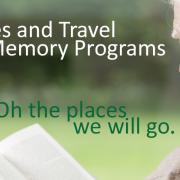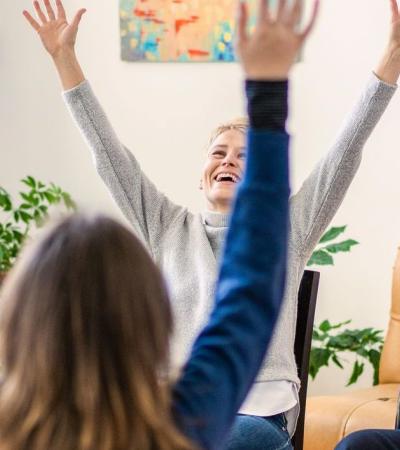Through Tales and Travel, the Gail Borden Public Library seeks to reach a stigmatized population: older adults with early- to mid-stage dementia. This monthly “excursion,” offered at 17 assisted-living facilities in the region by the end of 2017, takes participants on an imaginary trip to another country or region of the United States using library materials (e.g. books, music and objects).
Advanced Planning
Tales and Travel was created in 2008 by Mary Beth Riedner, a retired librarian whose husband was diagnosed with young-onset dementia. She describes the program in the video below.
One step in the process was creating 31 excursions to be used in programs in residential centers plus 8 traveling kits for 28 day loan check-out.
Each traveling kit included a relevant story — often taken from a children’s folktale collection and re-typed in a larger font (16 pt. Arial) for easier reading. The kits also contained adult and children’s non-fiction books about the destination, along with music, a DVD and other sensory items. The kits are designed to provide a program experience in a one-on-one setting, enabling caregivers to engage with their loved ones in new ways, stimulate conversation and reminisce, and may also used by activity directors outside of library programs.
The Excursion Guides are free and downloadable for group programs. Each Excursion Guide includes destination-specific folktales, tips for conducting a successful Tales and Travel Memories program, facts about the destination, list of suggested supplemental materials and web-based resources, an annotated bibliography detailing top titles for each destination. Books pulled from the library’s general collection for Excursions are determined by the number of participants.
There are Excursion Guides and Folktales for each city. See examples for Mexico and Japan in the attachments section.
Marketing
Within our community, marketing is achieved through in-person outreach, phone calls, email and fliers. We contacted memory care facilities and coordinated with their print activity calendars, bulletin boards and activity directors.
We use all the tools to get the message out — print, online, social media, in-person, phone, SMS and of course, library shelf space and the library catalog. Our Tales and Travel kits are also advertised by fliers and in person at our Memory Cafes, which started in August 2018.
We wanted communities even outside of our library district to know about this program, so we spread the word through our partners. We shared our idea at various library conferences and webinars and created a Tales and Travel Memories website to help share our materials with other care providers and libraries.
Budgeting
The start-up costs for launching Tales and Travel excursions at 17 locations was funded by a $5,000 ALA 2013 Carnegie Whitney grant. We used a few cost-cutting measures: we weeded our library’s collection to find books and DVDs that would be useful to the program, and the library’s book sale donated many items.
We received a $15,000 grant from the National Network of Libraries of Medicine (NNLM) to study the effectiveness of Tales and Travel. The NNLM 2015 grant funded the creation of 8 traveling kits to circulate in carry-on suitcases, a budget of $3,850. The hard-sided cases with 360 degree wheels in bright prints are best. The study was conducted in 2015-2016. Results are available on the Tales and Travel Memories website.
Day-of-event Activity
The facilitator should arrive at the location at least 15 minutes early to set up. We typically arrange tables in a U-shape to allow participants to see one another and to promote ease of use of materials. Turn off any distracting background noises, such as TVs or music, and greet each person by name as they arrive. A staff member from the assisted-living facility should attend in case any physical/mental needs arise.
During the program, “travelers” take turns reading out loud from a folktale, legend or myth associated with that month’s chosen location. We share a one-page document containing five interesting facts about the location; the page should use large print and have lots of white space. Some participants will want to read from books or the list of facts aloud while others listen.
Afterwards, they are invited to browse through a selection of books. We curate these books carefully, drawing on adult books with many color photographs, such as travel and coffee table books, as well as children’s books. There should be at least one book for each person to browse through and individulas can look through more thanone book. As they look through the books, library staff and volunteers walk around and engage participants in conversation, encouraging them to talk about memories from their own lives. If participants are unable to hold books or items, adapt to their physical needs.
It’s important to give people time to process your comments. Give only one instruction at a time and ask open-ended questions that don’t require a “correct” answer. See a program checklist for more tips.
Program Execution
We approached the Tales and Travel project with four major objectives to ensure success, and we evaluated our program to gauge our effectiveness. We found the program to be effective, engaging, and successful at reducing the negative stigma held of those with dementia.
Gail Borden Public Library received a target grant from NNLM to study the effectiveness of the program. In short, we found that Tales and Travel improved individuals’ cognitive and social interactions; positively affected the relationship between the caregivers and the individuals with dementia; helped reduce stressful interactions; and decreased stigma and stereotypes of adults with dementia. It also expanded the library’s outreach into an underserved population.
We shared the results of our study at professional library and aging conferences. We also created a website to provide library staff, caregivers and memory care providers resources for holding their own Tales and Travel programs. The website includes access to the Tales and Travel book lists and program logos at no cost.
Below is a webinar we presented with NNLM.
Advice
According to the Agency on Aging, for every person with dementia or mild cognitive impairment, ten others – family members and caregivers – are affected.
We strongly recommend a public library to undertake an initiative like Tales and Travel to help bridge the gap between people with dementia and their communities. Encouraging literacy opportunities that will engage a group of people can and does improve the quality of their lives.
The Gail Borden Public Library District invites library workers to replicate the Tales and Travel program. Get started at the Tales and Travel Memory Programs website.
Supporting Materials
- Feedback (Coming Soon!)
- Programming Librarian Facebook Group






